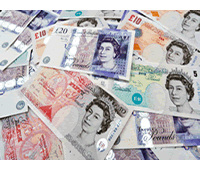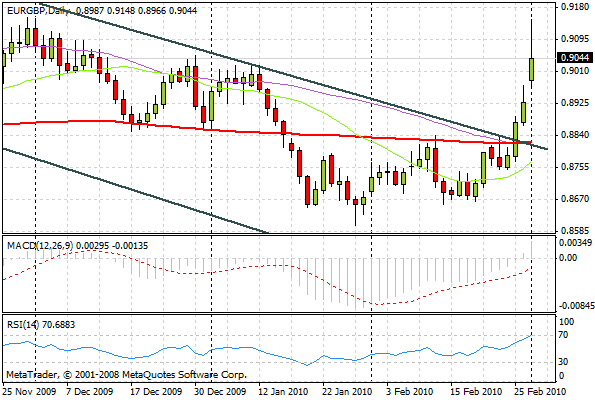Source: ForexYard
The U.S. Dollar and Yen firmed against most major counterparts on Monday as investors trimmed stretched risk positions in higher-yielding currencies. The safe heaven currencies were bolstered by continuing investor concerns over mounting fiscal problems in Euro-zone countries and doubts over the pace of the worldwide economic recovery.
Economic News
USD – Dollar Rises on Manufacturing Data
The dollar has strengthened against most of its major counterparts on Monday after data showed the U.S. manufacturing sector grew in February, although at a slower rate than expected, and worries about Greece’s financial stability sent investors to the U.S currency safety. As a result, the USD finished yesterday trading session around 200 pips higher against the GBP at the1.4935 level. The greenback also saw bullishness against the EUR and closed at 1.3520.
U.S. manufacturing output expanded in February for a seventh straight month, as factory output has provided one of the few areas of strength for the economy. The Institute for Supply Management’s factory index fell to 56.5, lower than anticipated, from January’s 58.4, which was the highest since August 2004. The manufacturing revival may help lead to the job growth needed to propel consumer spending and the economy.
Sentiment in the U.S economy has brightened in the past month following better-than-expected news. The USD is showing signs of resilience even though there was volatility throughout non-USD crosses. It will be crucial for traders to identify how the preceding economic indicators from the U.S., European and Japanese economies will affect their positions.
Investors may look for the unusual price volatility to continue in the EUR/USD as the pair attempts to stabilize and find new support and resistance lines. Large price jumps such as these are not common place and present terrific opportunities to take advantage of the price swings for large profitable gains.
EUR – GBP/USD Hits 10-Month Low
The EUR fell more than 1% against the U.S. dollar on Monday, led by a selloff in sterling and as uncertainty remained over a bailout package for debt-strapped Greece. As a result, the EUR/USD fell more than 100 pips before rebounding to its current level of 1.3520.
T
he pound fell to a 10-month low versus the greenback and was on track for its biggest one-day drop in a year after a poll showed increased risk that no party will win a majority in this year’s general election, triggering fears decision-making would become stymied. Heavy selling pressure in sterling triggered a move lower in the EUR, which had been steady earlier in the global session on hopes Greece may be nearing a deal with EU governments to take more budget steps in exchange for some form of emergency aid.
Looking ahead to today, the most important economic indicator scheduled to be released from the Euro-Zone is the CPI Flash Estimate at 10:00 GMT. Analysts are forecasting this figure to be unchanged from previous reading. Traders will be paying close attention to today’s announcement as a stronger than expected result may boost the EUR in the short-term. Traders are also advised to follow the Construction PMI figures coming out of Britain at 9:30 GMT, as these results may set the GBP’s main currency crosses going into the rest of the week.
JPY – Yen Gains on Return to Risk Aversion
The yen rose against the GBP and EUR on Monday as investors trimmed stretched risk positions in higher-yielding currencies. The JPY was bolstered by continuing investor concerns over mounting fiscal problems in Euro-zone countries and doubts over the pace of the worldwide economic recovery. By yesterday’s close, the JPY rose against the GBP, pushing the oft- traded currency pair to 133.35. The yen also saw bullishness against the EUR and closed at 120.70
Further strengthening could be seen in the Yen if other nations begin to raise interest rates in order to ward off inflation. This could potentially wreak havoc on the Japanese economy by making Japanese exports relatively more expensive when compared to their foreign counterparts
Oil – Crude Oil Falls on Strong Dollar
Crude oil gave back earlier gains Monday and slid on a rising dollar and a manufacturing report that fell short of economists’ expectations. Oil prices got to $80.60 a barrel before falling back to settle at $78.72, down around $1.90. The $80 level has been tough for oil to crack.
A stronger dollar also was a drag on oil Monday. Oil is traded in dollars on global markets and becomes more expensive for international investors who hold other currencies.
For now it seems that Crude Oil prices will continue to drop for as long as the USD continues to appreciate. Traders are strongly advised to follow the USD against its major pairs and crosses in order to try to predict today’s developments.
Technical News
EUR/USD
The hourly chart is showing the potential for bearish trading today. The chart displays the Relative Strength Index is trading in the overbought zone, indicating the potential for a downward correction. Traders may prefer to be short on this pair today.
GBP/USD
The cross has been dropping for the last day now, as it now stands at the 1.4933 level. The Slow Stochastic of the hourly charts shows a bullish cross has recently formed, indicating that an upward correction is imminent. The RSI of the hourly charts shows the pair sitting in the oversold territory, indicating that the next move may be in an upward direction. Going long with tight stops may turn out to be the right choice today.
USD/JPY
The sharp bearish move that took place during the past couple of days seems to have more steam in it. The RSI on the hourly charts is crossed above the 40 line, suggesting that the pair may fall further. The bearish move on the 30min. chart Slow Stochastic also supports this notion. Next target could be 88.80
USD/CHF
The pair has experienced a bullish run for the past week-and-half now, and currently stands at the 1.0809 level. The RSI of the 30min. chart shows the pair floating in the overbought territory, signaling that a bearish correction is imminent. This view is also supported by the MACD of the weekly chart. Entering the trend at an early stage may turn out to bring high returns, as end-of-week trading kicks in
The Wild Card
GBP/AUD
It appears as if the Bollinger Bands on the hourly chart have begun to tighten in expectation of a volatile movement. Most indications show the pair floating in neutral territory, which is common before a large jump. Signals are strongly in favor of a downward movement in the coming days and forex traders can benefit by riding out this momentum by placing early sell positions.
Forex Market Analysis provided by Forex Yard.
© 2006 by FxYard Ltd
Disclaimer: Trading Foreign Exchange carries a high level of risk and may not be suitable for all investors. There is a possibility that you could sustain a loss of all of your investment and therefore you should not invest money that you cannot afford to lose. You should be aware of all the risks associated with Foreign Exchange trading.
 session. Today’s UK Construction PMI did print a tad below analyst expectations, though this release doesn’t seem to be having too much of an impact on the Cable. The Pound is still at a comparative disadvantage, reflected by the EUR/GBP’s outbreak. Although the U.S. data wire is relatively quiet today, activity could pick back up tomorrow with the UK releasing its Services PMI and Halifax HPI data. The U.S. will also release its own Services PMI along with a much anticipated ADP Non-Farm Employment Change figure. However, investors should keep in mind that more emphasis is normally placed on Friday’s headline number rather than tomorrow’s ADP due to its unreliability. Regardless, volatility could kick back in, particularly with the BoE and ECB making their monetary policy decisions on Thursday. Investors will enter the BoE’s meeting with a bit of uncertainty since the central bank’s governors have been erring on the dovish side lately. Any surprise increase in QE could send the Cable reeling lower again since the Fed has maintained a neutral policy stance. Meanwhile, it will be interesting to see whether the Cable can garner enough strength to continue its consolidation around 1.50.
session. Today’s UK Construction PMI did print a tad below analyst expectations, though this release doesn’t seem to be having too much of an impact on the Cable. The Pound is still at a comparative disadvantage, reflected by the EUR/GBP’s outbreak. Although the U.S. data wire is relatively quiet today, activity could pick back up tomorrow with the UK releasing its Services PMI and Halifax HPI data. The U.S. will also release its own Services PMI along with a much anticipated ADP Non-Farm Employment Change figure. However, investors should keep in mind that more emphasis is normally placed on Friday’s headline number rather than tomorrow’s ADP due to its unreliability. Regardless, volatility could kick back in, particularly with the BoE and ECB making their monetary policy decisions on Thursday. Investors will enter the BoE’s meeting with a bit of uncertainty since the central bank’s governors have been erring on the dovish side lately. Any surprise increase in QE could send the Cable reeling lower again since the Fed has maintained a neutral policy stance. Meanwhile, it will be interesting to see whether the Cable can garner enough strength to continue its consolidation around 1.50.







